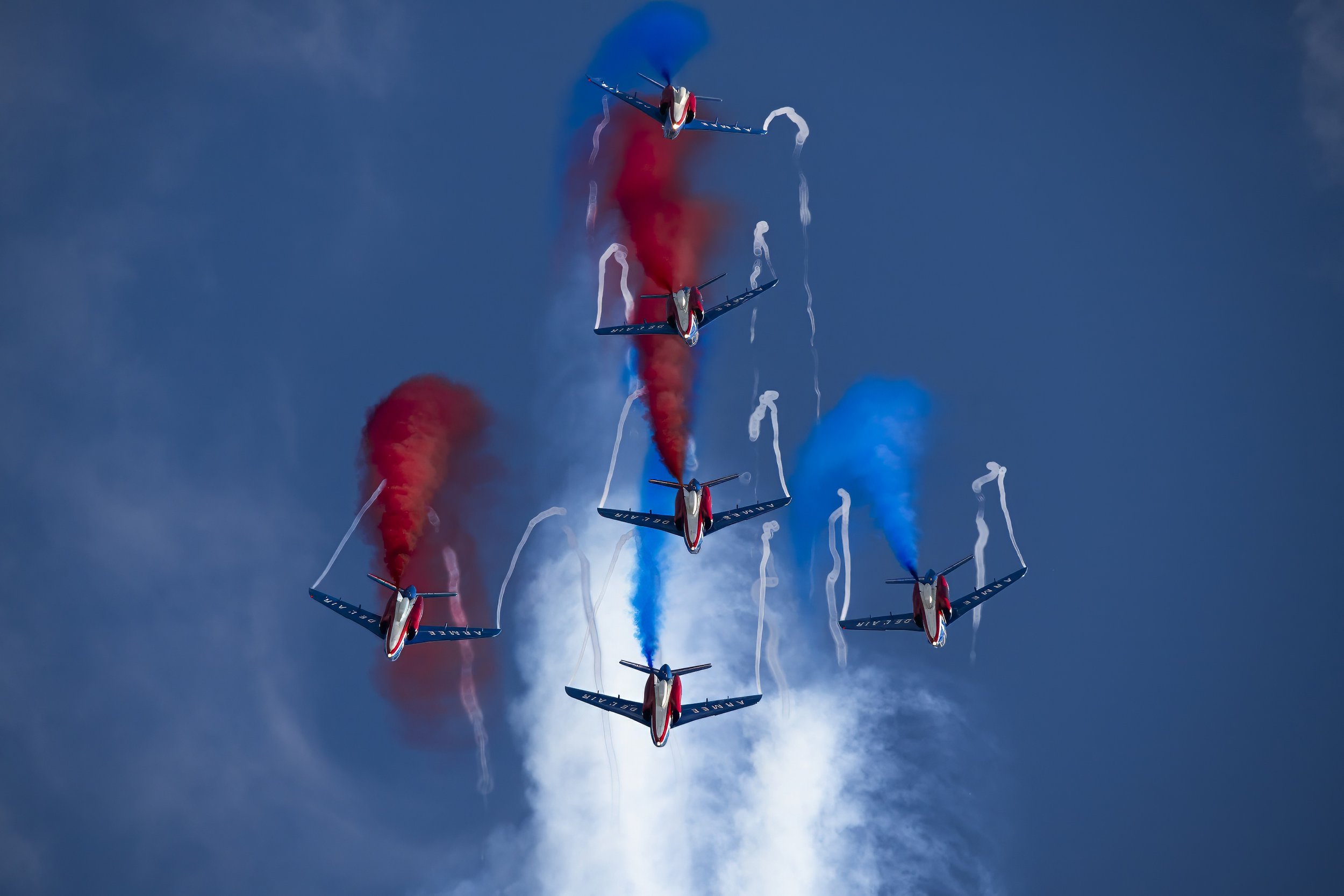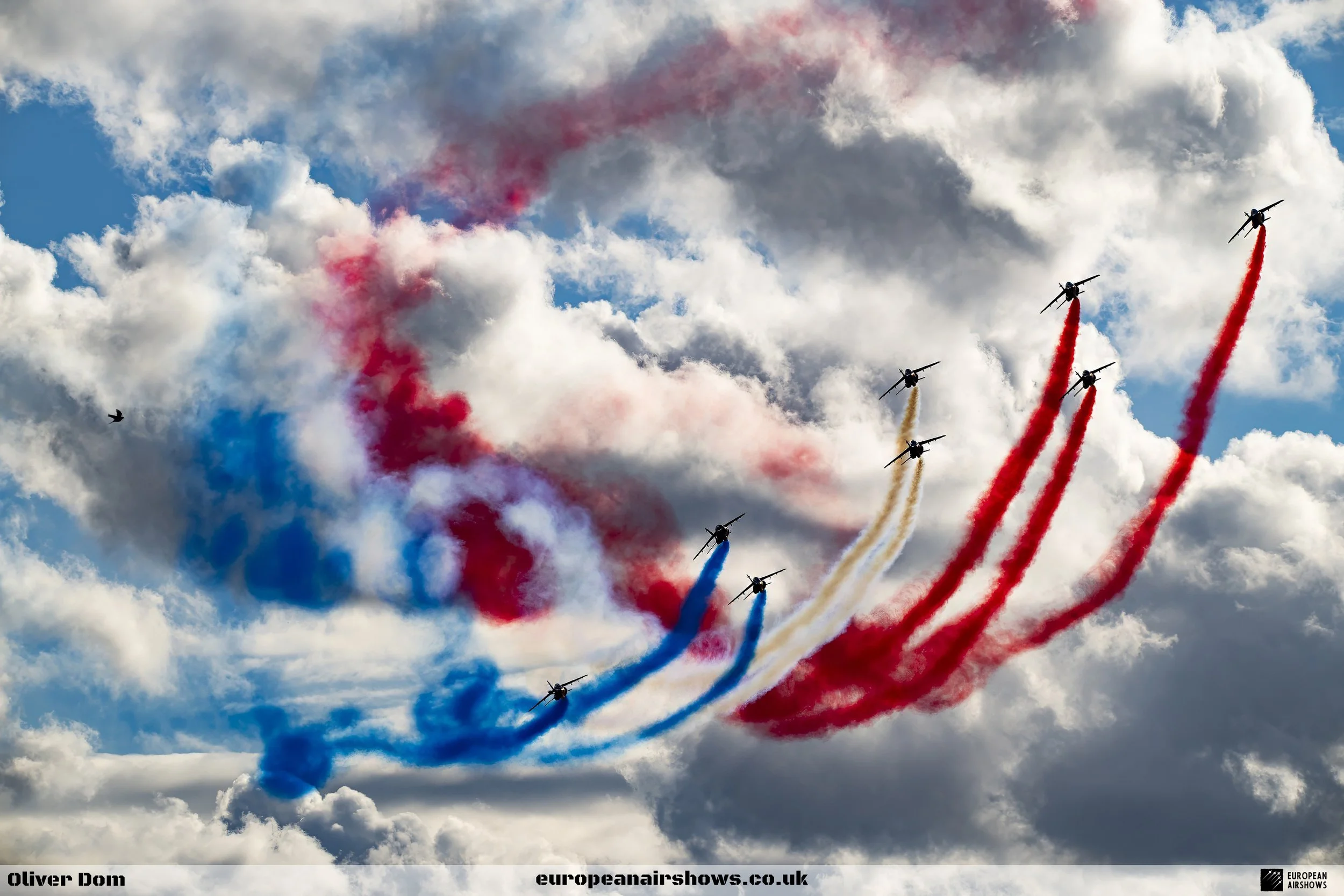
September 14 / Patrouille de France formally commissioned
Formally commissioned 14 September 1953
Patrouille de France
The Patrouille de France is the precision aerobatic demonstration team of the French Air and Space Force, renowned for its breathtaking aerial displays and rich history. Established in the aftermath of World War II, the team has become a symbol of French aviation prowess and national pride, captivating audiences with its stunning formations and intricate manoeuvres.
The origins of the Patrouille de France can be traced back to 1953, a time when the French military was seeking to showcase its capabilities and foster a sense of national pride in the post-war era. The French Air Force recognized the potential of an aerobatic team to demonstrate the skill of its pilots and the capabilities of its aircraft. The team was officially formed on May 18, 1953, initially under the name “Patrouille de France,” and it was composed of pilots from various squadrons.
The first aircraft used by the Patrouille de France was the Fouga Magister, a two-seat jet trainer that had been introduced into service in the late 1950s. The Magister was well-suited for aerobatic performances due to its agility and relatively low speed, allowing the pilots to execute complex manoeuvres while maintaining control. The team’s first public performance took place in 1955, and it quickly gained recognition for its precision flying and coordinated formations.
As the team evolved, so did its repertoire of manoeuvres. The Patrouille de France became known for its signature formations, including the iconic “V” formation and the “Diamond,” where the aircraft flew in close proximity to one another, creating visually stunning displays. The pilots’ ability to perform intricate aerial choreography, often just a few meters apart, showcased their exceptional skills and training.
In the 1960s, the Patrouille de France began to expand its reach, performing at airshows and events not only in France but also internationally. The team participated in various airshows across Europe and beyond, gaining acclaim for its professionalism and the artistry of its performances. The Patrouille de France became a symbol of French aviation, representing the country’s commitment to excellence in the skies.
In 1964, the team transitioned to the Dassault Mirage III, a supersonic fighter aircraft that significantly enhanced its performance capabilities. The Mirage III allowed the Patrouille de France to reach higher speeds and perform more dynamic manoeuvres, further elevating the team’s reputation. The aircraft’s distinctive delta wing design contributed to its agility, and the team quickly adapted to the new platform, incorporating its unique characteristics into their routines.
Throughout the years, the Patrouille de France has participated in numerous high-profile events, including national celebrations, military parades, and international airshows. One of the most notable occasions was the annual Bastille Day parade on July 14, where the team performed spectacular flyovers above the Champs-Élysées in Paris, showcasing the pride of the French military and the nation as a whole. These performances became a cherished tradition, drawing large crowds and reinforcing the team’s status as a national symbol.
In the 1980s, the Patrouille de France continued to innovate, incorporating new manoeuvres and formations into its displays. The team began to emphasize the importance of teamwork and coordination, with pilots undergoing rigorous training to ensure the seamless execution of their routines. The Patrouille de France also became known for its distinctive colour scheme, featuring the blue, white, and red of the French flag, which added to the visual impact of their performances.
In 1981, the team transitioned to the Alpha Jet, a light attack and advanced trainer aircraft that would become synonymous with the Patrouille de France. The Alpha Jet’s agility and versatility made it an ideal platform for aerobatic demonstrations, allowing the pilots to perform a wide range of manoeuvres while maintaining precise control. The aircraft’s design also facilitated the execution of complex formations, further enhancing the team’s performance.
As the years went by, the Patrouille de France continued to adapt to changing technologies and aviation practices. The team embraced advancements in avionics and flight safety, ensuring that its performances remained at the cutting edge of aerobatic flying. The pilots underwent extensive training, honing their skills in various weather conditions and flight scenarios to prepare for the challenges of public performances.
In addition to their dazzling displays, the Patrouille de France has played a significant role in promoting aviation and inspiring future generations of pilots. The team has participated in educational outreach programs, visiting schools and engaging with young people interested in aviation. Through these initiatives, the Patrouille de France has fostered a sense of excitement about aviation and encouraged young individuals to pursue careers in the field.
The team has also been involved in humanitarian efforts, using its performances to raise awareness for various causes and support charitable initiatives. The Patrouille de France has participated in events to benefit organizations focused on health, education, and environmental conservation, reinforcing its commitment to making a positive impact beyond the realm of aviation.
In recent years, the Patrouille de France has continued to captivate audiences both in France and around the world. The team has participated in international airshows, showcasing its skills alongside other renowned aerobatic teams. The Patrouille de France’s performances have become a highlight of these events, drawing admiration from aviation enthusiasts and casual spectators alike.
As the team celebrates its legacy, it remains committed to excellence in aerobatic flying and the promotion of French aviation. The Patrouille de France stands as a testament to the dedication of its pilots, the innovation of its aircraft, and the enduring spirit of aviation in France. Its history is not just a chronicle of aerial performances; it is a story of passion, teamwork, and the pursuit of excellence in the skies.
In conclusion, the Patrouille de France has established itself as one of the premier aerobatic teams in the world, with a rich history that reflects the evolution of military aviation in France. From its humble beginnings in the 1950s to its current status as a symbol of national pride, the team has consistently demonstrated the artistry and skill of its pilots. Through its performances, the Patrouille de France has inspired generations, leaving an indelible mark on the world of aviation and solidifying its place in the hearts of people both in France and beyond.
Patrouille de France Facts
Established in 1953: The Patrouille de France was officially formed in 1953, making it one of the oldest aerobatic teams still in operation today. It was created to showcase the capabilities of the French Air Force and to promote aviation.
Aircraft Evolution: The team initially flew the Fouga Magister, a jet trainer, before transitioning to the Dassault Mirage III and later the Dassault Alpha Jet, which is the aircraft they currently use for their performances.
Colourful Smoke: The Patrouille de France is known for its colourful smoke trails, which are created using a mixture of oil and dye. The team uses blue, white, and red smoke, reflecting the colours of the French flag.
Formation Flying: The team typically performs in a formation of six aircraft, although they can also perform in various formations with more aircraft for special events. Their precision flying and synchronized manoeuvres are a hallmark of their performances.
International Appearances: The Patrouille de France participates in airshows and events worldwide, showcasing French aviation and culture. They have performed at prestigious events such as the Melbourne Air and Space Show in the US and the Royal International Air Tattoo in the UK.
Training Program: Pilots for the Patrouille de France are selected from experienced fighter pilots in the French Air Force. They undergo a rigorous training program that includes extensive aerobatic training and teamwork exercises.
Public Engagement: The team is not only focused on aerial performances but also engages with the public through educational programs and outreach initiatives. They aim to inspire future generations to pursue careers in aviation and aerospace.
Signature Formations: The Patrouille de France is known for its signature Formations, such as the “Apollo,” “Chevron,” and the “Diamond” formations, all performed with all 8 aircraft in close formation.
Team Motto: The Patrouille de France’s motto is “L’esprit de l’escadron” (“The Spirit of the Squadron”), which reflects their commitment to teamwork, precision, and excellence in aviation.
Cultural Symbol: The Patrouille de France is considered a symbol of French pride and excellence in aviation. They often perform during national celebrations, including Bastille Day, and their displays are seen as a celebration of French culture and heritage.



















